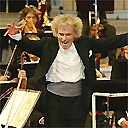
Our boy has made it. In charge of the best orchestra in the world at 48. Every street corner in Berlin decorated with twice-lifesize welcome posters bearing the trademark curly grey locks and the dimpled smile. A city unified and resurgent (if broke). An orchestra and an audience eating out of the palm of his hand. Life does not get much better than this.
Exactly four years ago Simon Rattle said goodbye to Birmingham with Thomas Adès and Mahler. On Saturday night he said hello to Berlin with the same piece by Adès (Asyla) and Mahler (the fifth, rather than the second). Gallons of ink have been spent wondering about what signal Rattle was sending his new colleagues and public. Adès=change, Mahler=continuity: Adès=danger, Mahler=safety. And so on.
Well, possibly. In reality the Adès is not so very dangerous and, in Rattle's hands, Mahler is not so very safe. But plunging straight into the deep end with a vibrant and challenging piece of new British music was bold. And combining it with a masterly and fluid reading of an old favourite about to celebrate its century with the orchestra was astute. But then, that was why they hired him.
The Philharmonie Hall was, predictably, packed and palpably buzzing with civic pride and a sense of anticipation for not just the next couple of hours but - in Berliners' secret dreams - the next couple of decades. Saturday night was the beginning of a journey.
The journey began with the strange Balinese tones of the Adès work, said to be a play on the refuge/madhouse connotations of the word "asylum". In truth there is more madhouse than refuge in this four-movement minor masterpiece. Over the next 20 or so minutes we were subjected to the most graphic representation of madness: shrieks, wails, moans, bangs, mis-tunings, pain, sadness, alienation and the extremes of noise and quiet.
It is an unflinching and profound work - easy to see why Rattle is attached to it, and little wonder Adès is reported to have ended up hyperventilating in casualty the night he tried to finish off the frenetic third movement. Most of the audience was also hyperventilating as it furiously built on its own remorseless momentum. There was a telling moment when a bass player, startled by the furious drumming behind him, looked over his shoulder and then - there is no other word for it - began to jam.
There was no jamming in the Mahler, but there was plenty of spontaneity and impulsiveness. Rattle woos his players, cajoles them, alarms them. Sometimes he abandons the beat and describes the sound he's after with his left hand. There is no part of his body he won't use to implore or impose the effect he wants - eyes, mouth, left elbow, forehead, back muscles, hair, feet.
It all came together in an account of the Mahler that was, by some way, less rushed than some previous rattles through the work. There was a real sense of the overall architecture and drama - but plenty of whimsy, fun and mischief along the way. And if there is a more velvety string section anywhere in the world, it would be good to know of it.
At the final brass chorale Rattle simply stared at the brass section, raised his arms to the heavens and opened his mouth in glory. As the applause rolled around the hall the new Maestro was glimpsed between third and fourth trombone lapping it up. Our boy had well and truly arrived.

